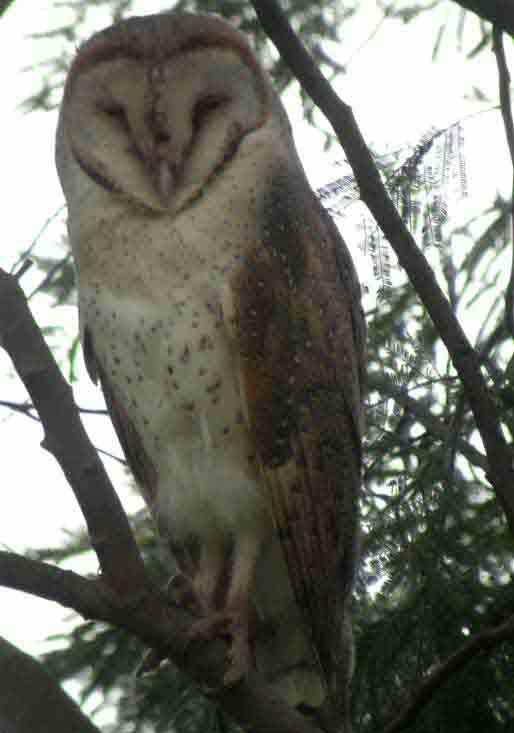Owl - barn
Delicate Owl, Monkey-Faced Owl, White Owl Scientific Name: Tyto alba
Sun, 27th April, 2025 - 12:55 am GMT
Sponsor Ads:

Alternative Name
Delicate Owl, Monkey-Faced Owl, White Owl Scientific Name: Tyto albaBasic Info
Barn Owls are lovely, and have been called Delicate Owls, White Owls, or Monkey-Faced Owls because of their appearance. The white face is a heart-shaped disc, serving as a satellite to direct all sound to asymmetrically placed ears. This allows Barn Owls to locate their prey through sound triangulation. The eyes are dark and the feathers of the body are generally tan or light golden brown. Barn Owls have light or white undersides, and knock-kneed legs. The legs are lightly feathered and the wings are long, spanning about 43 inches. The Barn Owl itself measures 14 to 20 inches. Males weigh about 20 ounces and females 24 ounces. The central talon of each foot has a serrated edge, used for straightening and grooming the beautiful Barn Owl's feathers.
Health
In many areas it is illegal to keep captive Barn Owls. Barn Owls and their nest sites are also protected from harassment or disturbance. In the areas where it is legal to keep captive Barn Owls some falconer's have used them for falconry purposes, but they are not considered nearly as good for this purpose as falcons or hawks. They are not able to pursue large quarry and are not as talented as hunting hawks or falcons. Nevertheless, falconers will use them in lovely flight displays. It is essential Barn Owls have plenty of space to fly in, a proper diet, and access to a veterinarian experienced and knowledgeable in the care of these Owls. Barn Owls are also susceptible to the dreaded Aspergillosis, and can very quickly die from it although it can be easily treated using a couple of different methods, the first being oral administration of an anti-fungal drug, combined with the use of a nebuliser filled with a solution of a proper disinfectant, these can be obtained through a veterinarian experienced with birds. Time is critical when treating Aspergillosis, and early treatment is advisable, although prevention is better than cure, never supply hay, straw, bark, or wood shavings for nesting or floor coverings as the Aspergillus fungus grows readily on the items. Breeding Barn Owls mate for life. In the wild, Barn Owls use previously existing nests or niches in man-made, abandoned or secluded structures in which to lay five to 12 white eggs. These eggs are laid at one to two day intervals and will be incubated for 31 days. It is not legal to breed Barn Owls in all areas. For example in most circumstances it is illegal in the United States. IN the United Kingdom it is legal as long as the parent birds are legally held in captivity at the time the eggs are laid. If you plan to breed Barn Owls it is important to check with local fish and game authorities before attempting breeding. In some places, where it is legal special permits may be needed. Barn Owls are prolific breeders in captivity, and merely placing a suitable pair together with a nest box will result in some sort of progeny, depending on the conditions in which they are housed and the food fed, if the nest box is disturbed at all during the incubation and early rearing stages, the result is that the parents will inevitably destroy the eggs or kill the young and after a wait start over again. Incubation of eggs is usually 31 days and the eggs are laid 2 days apart. Barn Owl chicks stay covered in the snow white down until the feathers grow, the first feather growth is from the primary flight feathers on the wings and is evident from about 21 days old, completing around eight weeks old depending on food intake. Chicks will eat about twice as much as adults in the growing stages; this is required to cope with feather and body structure growth.Habitat
Found throughout North, Central, and South AmericaBehavior
Though the Barn Owl is distributed worldwide, save Antarctica, it is nevertheless an endangered species in the United States and Europe. Living closely in conjunction with humans in barns and fields, this lovely Owl plays an important part in rodent control. Different subspecies of Barn Owl are found on every continent except Antarctica. These lovely birds do not build their own nests but prefer to takeover squirrels' or other birds' nests and especially love living in dark places like barns, belfries, or tree cavities. They hide here in the day, sleepy and inactive. Barn Owls prefer sites, which were previously inhabited by other Barn Owls, as these birds do not stay in one place for very long, rather wandering after food. Generally, they inhabit a range of about two and a half square miles, which will overlap with other owls' ranges, as Barn Owls are not territorial. They hunt by listening for the movements of their prey, flying silently over fields and swooping when they have determined the location of their quarry. They hunt at dawn and dusk, and must eat about one third of their body weight every night! Barn Owls mate for life and generally remain solitary, but some Northern-dwelling Barn Owls migrate south in the winter, and will roost in groups of up to fifty along the migratory route! Not all northern Barn Owls will migrate, however, and it should be noted that the British Columbian population of Barn Owls, which is located at the northernmost edge of the species' western North American range are resident all year. Band recoveries within British Columbia are mainly within 20 kilometers of the place of banding, with no evidence of any concerted southward movement. Warm climates and mild winters please these Owls best. Generally, Barn Owls do not hoot; rather they hiss sharply or eerily screech, and have even been heard to purr or cluck. When Barn Owls feel threatened, they "dance" and "toe-dust", waving and bobbing their heads over their toes and screeching. Barn Owls have no specific breeding season and they will generally breed up to three times a year. They raise large clutches, which is necessary since approximately 60 percent of young Barn Owls will die before reproducing. Their breeding chronology is controlled by their food supply. If there is a good vole population, they will breed even in the winter. Conversely, if prey is scarce they may not breed at all. It has proved nearly impossible to reintroduce captive bred Barn Owls into the wild and this is now illegal. Barn Owls do, however, love man-made nesting boxes and these prove to be the best conservation attempt possible by individual humans. They have been used in falconry but are not as apt for this use as other birds. Barn Owls live about three years in the wild; in captivity they live an average of 20 years.Origin
N/AHistory
The Barn Owl is truly international and subspecies are found on every continent excepting Antarctica, and these Owls prefer to live close to meadows and grain fields. However, due to habitat loss, hunting, poisoning, predation by Great Horned Owls, and the loss of agriculture fields, Barn Owls are endangered in the U.K. and the U. S.Common Foods
Barn Owls prefer field voles, but also eat rats, mice and sometimes small rabbits or large insects or frogs.Sponsor Ads:
"In crossing salt-marshes, your sole concern should be to get over them quickly, without any delay." -- Sun Tzu, The Art of War
Owl - barn
Coded by: BGID® | ALL RIGHTS RESERVED Copyright © 2000-2025
Disclaimer | Privacy | Report Errors / Contact | Credits








 President of the United States of America - Real Estate mogul, Pageant owner and now one of the most controversial men in political history.
President of the United States of America - Real Estate mogul, Pageant owner and now one of the most controversial men in political history.  Politician, US Vice President and President of the USA - Joseph Robinette Biden Jr.
Politician, US Vice President and President of the USA - Joseph Robinette Biden Jr.  versus
versus  Russia: 'The Evil Empire'? Are they all that bad or is it just the USA trying to portray Russia as bad because they are a world power with land bigger and a society very different from the USA ideal?
Russia: 'The Evil Empire'? Are they all that bad or is it just the USA trying to portray Russia as bad because they are a world power with land bigger and a society very different from the USA ideal?  Global warming has been in and out as the "latest" hot topic for many years. It is, according to modern scientists, the result of man-made industrial pollutants, clearing forested areas, agriculture, etc. But now they are thinking it started way before the Industrial Revolution...
Global warming has been in and out as the "latest" hot topic for many years. It is, according to modern scientists, the result of man-made industrial pollutants, clearing forested areas, agriculture, etc. But now they are thinking it started way before the Industrial Revolution... 
 Corona virus
Corona virus 
 Users with wide screen monitors can benefit from more content on every page.
Users with wide screen monitors can benefit from more content on every page.